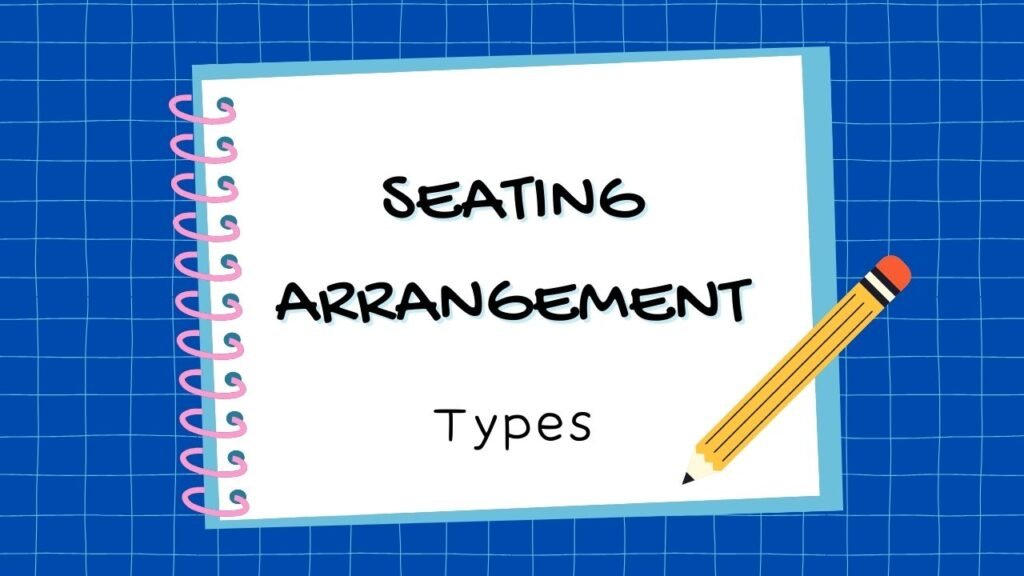6 Types of Seating Arrangement Puzzles
Seating Arrangement Puzzles
Let’s explore different types of seating arrangement puzzles with solved examples. Type 1 and Type 7 are extensions of Linear arrangement. All the puzzles can be mixed with multiple variable to make the overall problem seem complicated.

Type 1 – Row Arrangement
*Linear arrangement – Horizontal
This type of puzzle is easy to solve, the difficulty level increases with the number of subjects seating in the same line along with directions.
Nine persons Anu, Bablu, Cheenu, Dona, Esha, Faria, Gaurav, Harish and Ishita are sitting in a row and all are facing north. It is known that Cheenu sits exactly in the middle and there is no person to the right of Ishita. Dona is fourth to the right of Faria. Gaurav and Harish are sitting next to each other.
Esha is the neighbour of Dona but not of Cheenu. Harish doesn’t sit at an extreme corner. Dona is not sitting adjacent to either Cheenu or Ishita. Anu is second to the right of Harish.
Solution:
| Gaurav | Anish | Faria | Anu | Cheenu | Bablu | Dona | Esha | Ishita |
Type 2 – Circular Arrangement
The circular arrangement puzzles can be inward or outward-facing type, inward + outward in the same case, inward + outward with Blood Relations.
Eight persons – Navya, Farukh, Ankur, Mangal, Ravan, Danav, Simar, and Gopal are seated around a circular table such that only three of them are facing away from the centre and the rest are facing towards the centre (not necessarily in the same order). Navya sits second to the left of Ankur. Farukh is not an immediate neighbour of both Ankur and Navya. One of the immediate neighbours of Ankur faces the opposite direction of Ankur. Gopal sits third to the left of Navya.
Danav sits second to the left of Gopal. Mangal is not an immediate neighbour of Farukh. Simar sits third to the left of Mangal. Ravan and Farukh face the same direction as Mangal faces. Farukh doesn’t sit opposite to both Ankur and Navya.
Type 3 – Square or Rectangle Arrangement
You can easily solve this type if you are comfortable with Circular.
Eight students Aadvik, Tanish, Jiral, Vaibhav, Yashith, Bhavin, Rithwik and Kiansh sit in a square table. Four persons sit in each corner of the table and four persons sit in each side of the table but not necessarily in the same order. All are facing outside. Aadvik is the immediate neighbour of Kiansh.
Bhavin does not sit third to the left of Tanish who doesn’t sit at the corner. Bhavin sits fourth to the right of Yashith. There are three persons who sit between Tanish and Jiral. Jiral sits third to the left of Vaibhav. One person sits between Jiral and Kiansh. Rithwik and Kiansh are not immediate neighbours.
Type 4 – Parallel Arrangement
This is an extension of Linear arrangement but with multiple variables.
Twelve persons are sitting in two parallel rows in such a way that the persons sitting in Row-1 face the persons sitting in the Row-2. Six persons A to F are sitting in the Row-1 and facing north direction. Six people P to U are sitting in the Row-2 and facing south direction. All the above information is not necessarily in the same order.
E sits second to the right of F. Two persons sit between F and B, who is facing R. Q and R are immediate neighbours. U sits second to the left of Q. The person who sits second to the right of P is facing C. More than one person sits between F and D. T does not sit at the extreme end of the line.
Solution:
| Person (Row-2)
South |
S | T | P | Q | R | U |
| Person (Row-1)
North |
C | F | A | E | B | D |
Type 5 – Matrix-based Arrangement
This type of puzzle is usually lengthy and takes a longer time to solve. It should be properly analyzed as it contains multiple variables with arrangement conditions.
Six friends Prakash, Qadir, Rithesh, Surya, Tarini and Umesh are sitting around the square table. All of them belong to different profession among Engineer, Doctor, Scientist, Banker, Lawyer and Teacher but not necessarily in the same order. Some of them are facing inside and some of them are facing outside. Four of them are sitting at the corner of the table and two are sitting on the opposite edges of the table. Not more than two consecutive sitting persons are facing the same direction.
Tarini, whose profession is Scientist, sits second to the left of Qadir and to the left person whose profession is Lawyer. Qadir sits at a corner and facing away from the centre of the table. The person sitting to the immediate right of Qadir is sitting at the corner of the table. Umesh, who is not the immediate neighbour of Qadir, is facing the person, whose profession is Doctor.
Surya, whose profession is Teacher, is an immediate neighbour of the person whose, the profession is Lawyer. Surya is not the immediate neighbour of Tarini. Rithesh is not sitting at the edge of the table. The immediate neighbours of Prakash are facing different directions. The one whose profession is Scientist is not sitting to the immediate right of the person whose profession is Banker. The person whose profession is Banker does not sit at the edge of the table. The person sitting at the edges are facing each other.
Type 6 – Floor Based or Box Arrangement Puzzles
*Linear arrangement – Vertical

